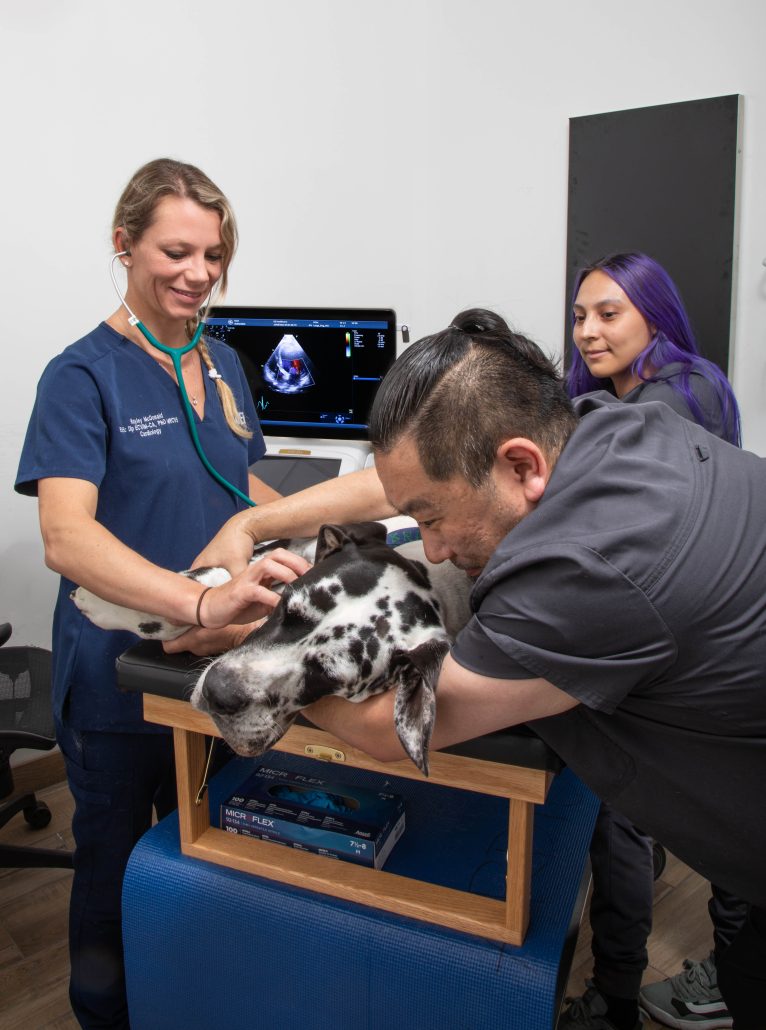The Duty of Ultrasound and CT Scan in Modern Vet Practices: Insights From Experienced Professionals
In contemporary vet methods, ultrasound and CT scans considerably enhance analysis abilities. These imaging methods give crucial insights right into animal health, assisting therapy decisions. Experienced specialists recognize the unique benefits of each modality. Ultrasound offers real-time evaluations, while CT scans provide complex anatomical details. Comprehending their duties and applications elevates important inquiries concerning their effect on individual outcomes and the future of vet diagnostics. What insights can be gotten from their combined use?
Understanding Ultrasound in Veterinary Medicine
Ultrasound is an essential diagnostic tool in vet medication, using a non-invasive technique to imagine internal frameworks. This imaging strategy utilizes high-frequency acoustic waves to create real-time pictures of body organs and cells, permitting vets to evaluate conditions without surgical intervention. Typical applications consist of examining the heart, liver, kidneys, and reproductive body organs, along with monitoring pregnancies.The treatment is relatively fast and can be executed in numerous settings, making it an easily accessible option for veterinarians. Unlike radiography, ultrasound offers in-depth information about soft cells and blood circulation, which is essential for exact diagnoses.Veterinary specialists count on ultrasound to identify problems such as growths, cysts, and fluid accumulation. Its capacity to direct biopsies and other treatments even more boosts its energy in medical technique. By offering a safe and reliable way to take a look at interior anatomy, ultrasound has actually become a keystone of modern-day vet diagnostics.
The Advantages of CT Scans for Animal Diagnostics
CT scans offer considerable benefits in veterinary diagnostics by offering enhanced accuracy in determining inner problems (CT Scans For Animals). As a non-invasive imaging method, they guarantee the safety and convenience of pets during assessments. In addition, CT checks facilitate a thorough evaluation of inner structures, enabling more efficient therapy preparation
Enhanced Analysis Precision
Advancements in imaging modern technology have actually substantially improved diagnostic accuracy in veterinary medication, especially through the usage of CT scans. These scans give in-depth cross-sectional photos of an animal's inner frameworks, permitting vets to determine abnormalities with precision. The high resolution and three-dimensional abilities of CT imaging help with the detection of conditions such as lumps, fractures, and inner blood loss that may be missed out on with standard imaging approaches. Furthermore, CT scans can assist in pre-surgical planning by supplying a detailed sight of physiological connections. This degree of detail not just boosts the accuracy of medical diagnoses yet likewise help in tailoring effective therapy strategies. The combination of CT modern technology right into veterinary practices is transforming the landscape of pet healthcare, enhancing outcomes for people.
Non-Invasive Imaging Strategy
The intro of non-invasive imaging methods has changed animal diagnostics, with CT checks arising as a famous device in vet methods. These scans give high-resolution, cross-sectional photos of an animal's interior structures, allowing veterinarians to examine intricate conditions without the need for invasive treatments. The advantages of CT scans include their capacity to identify tumors, fractures, and interior bleeding with impressive accuracy. Additionally, they promote the assessment of soft cells and body organs, improving diagnostic abilities. The speed of CT scanning enables quick decision-making, which is essential in emergency situations. By minimizing tension and discomfort for the animal, CT scans contribute to a more gentle strategy to diagnostics, ultimately improving treatment outcomes and progressing veterinary care.
Comprehensive Internal Assessment
A thorough interior evaluation is vital for precise medical diagnosis and reliable therapy in veterinary medication. CT checks deal significant advantages hereof, offering comprehensive cross-sectional pictures of an animal's interior structures. This sophisticated imaging technique enhances visualization of intricate anatomical areas, enabling veterinarians to identify abnormalities such as growths, fractures, and inner blood loss with greater precision. In enhancement, CT checks assist in the assessment of problems that may be testing to detect with typical methods. The rate and accuracy of CT imaging also add to prompt interventions, improving patient end results. As veterinary methods significantly incorporate CT modern technology, the advantages of extensive interior evaluations come to be obvious, strengthening the value of this tool in contemporary vet diagnostics.
Contrasting Ultrasound and CT Imaging Techniques
While both ultrasound and CT imaging offer crucial functions in vet diagnostics, each technique offers distinct benefits and restrictions that can influence scientific decision-making. Ultrasound is specifically valued for its real-time imaging capabilities, enabling vets to observe vibrant physical processes. This method is non-invasive, portable, and does not entail ionizing radiation, making it a more secure choice for both pets and clinicians. Ultrasound might have constraints in envisioning certain anatomical structures or deep tissues.Conversely, CT imaging supplies thorough cross-sectional views of the body, permitting for precise localization of problems. It excels in assessing complex organs and structures, especially in the thorax and abdomen. Nevertheless, CT scans call for sedation or anesthetic in most cases and entail direct exposure to ionizing radiation. Inevitably, the selection between ultrasound and CT depends on the particular scientific scenario, the location of interest, and the seriousness of the diagnostic demands.
Situation Studies: Successful Medical Diagnoses With Imaging
Study highlight the considerable renovations in analysis accuracy attained through sophisticated imaging technologies like ultrasound and CT scans in vet techniques. These improvements not only enhance the discovery of different conditions but also promote effective and prompt therapy strategies. Assessing particular cases can highlight the transformative effect of these imaging techniques on vet medicine.
Diagnostic Precision Improvements

Imaging Modern Technology Advancements
As veterinary imaging modern technology continues to advance, its influence on diagnostic capacities becomes progressively apparent. Recent study highlight the effective application of innovative ultrasound and CT check techniques in recognizing intricate conditions. For example, a veterinary facility used high-resolution CT scans to identify a rare type of lung cancer cells in a dog, which conventional imaging had missed. An ultrasound examination disclosed an abdominal mass in a pet cat, prompting prompt medical treatment and a favorable outcome. These advancements not just enhance analysis precision however likewise allow veterinarians to create targeted therapy plans. By leveraging sophisticated imaging technologies, vet specialists are considerably improving patient care, causing more reliable monitoring of various health conditions in pets.
The Role of Imaging in Emergency Veterinary Care
Imaging plays a necessary function in emergency vet care, providing veterinarians with essential info needed to make fast, enlightened decisions. In urgent circumstances, techniques like ultrasound and CT scans make it possible for practitioners to promptly evaluate a family pet's interior frameworks, identifying essential problems such as inner blood loss, fractures, or organ abnormalities. These imaging techniques permit real-time evaluations, promoting timely treatments that can be life-saving. For example, ultrasound is invaluable for evaluating soft tissue injuries and problems like liquid accumulation, while CT scans offer comprehensive pictures of complicated physiological frameworks, essential for detecting injury cases. The rate and precision of these imaging techniques improve the vet's capability to create effective treatment strategies, guaranteeing the most effective possible results for their clients. As a result, the combination of sophisticated imaging innovations right into emergency vet techniques is not just advantageous yet progressively necessary, as it boosts analysis capabilities and enhances overall animal treatment during critical moments.
Training and Experience in Vet Imaging
Advanced imaging methods such as ultrasound and CT scans are crucial for efficient veterinary care, the effective execution of these technologies heavily depends on the training and competence of vet professionals. Skillful use of imaging devices calls for comprehensive understanding of makeup, pathology, and the concepts underlying each modality. Vet professionals need to undergo specialized training to accurately interpret imaging outcomes, which is crucial for identifying conditions and planning treatment.Certifications and proceeding education in veterinary imaging boost the skills of specialists, enabling them to remain upgraded with technical improvements. Cooperation in view it now between radiologists and veterinarians often brings about boosted diagnostic precision, as professionals can offer understandings into complicated situations. Additionally, sensible experience in dealing with imaging devices cultivates confidence in its application. Ultimately, the top quality of vet imaging services is straight associated to the degree of training and experience possessed by the specialists using these important analysis tools.
Future Trends in Diagnostic Imaging for Animals
With the quick improvements in technology, vet analysis imaging is positioned for considerable development in the coming years. Emerging patterns suggest a shift in the direction of more obtainable and portable imaging techniques, such as portable ultrasound devices, which could enhance area diagnostics. In addition, the combination of fabricated knowledge is anticipated to change photo analysis, enabling quicker and more accurate analyses of results.Moreover, developments in 3D imaging techniques and calculated tomography will certainly give veterinarians with even more thorough views of pet composition, bring about enhanced treatment plans. Digital fact innovation may also contribute in medical preparation and education, offering vets an unique viewpoint on complicated cases.As telemedicine proceeds to expand, remote appointments facilitated by analysis imaging will become much more usual, allowing specialists to aid basic experts in real-time. On the whole, my website these trends are readied to improve the performance and efficiency of veterinary treatment, ultimately improving animal outcomes.
Often Asked Questions
Just How Much Do Ultrasound and CT Scans Price in Vet Centers?
The prices of ultrasound and CT scans in vet facilities typically vary from $300 to $1,500, depending on variables such as area, clinic type, and particular treatments required for the pet's medical diagnosis and therapy.

Are There Any Type Of Dangers Connected With Ultrasound and CT Scans for Pet Dogs?
Ultrasound and CT scans usually position minimal dangers to pets. Possible issues consist of sedation responses and direct exposure to anesthetics. Vets meticulously evaluate each instance to alleviate any type of dangers linked with these diagnostic treatments
For How Long Do Ultrasound and CT Treatments Typically Take?
Ultrasound treatments usually take about thirty minutes to an hour, relying on the complexity. CT scans, being more in-depth, typically need half an hour to 90 mins, including prep work and recovery time for the pet.
Can All Veterinarians Perform Ultrasounds and CT Scans?
Not all vets can perform ultrasounds and CT scans. Specialized training and qualification are often required to guarantee competency in these sophisticated imaging methods, which may limit their schedule to vets with added qualifications and resources.
What Sorts Of Pets Benefit A Lot Of From These Imaging Techniques?
Certain pet species, especially dogs and cats, benefit significantly from ultrasound and CT scans. These imaging techniques boost analysis accuracy for conditions like tumors, inner injuries, and body organ problems, resulting in better treatment outcomes and client care. The high resolution and three-dimensional page abilities of CT imaging assist in the detection of conditions such as tumors, cracks, and internal blood loss that might be missed with typical imaging approaches. Situation studies show the substantial enhancements in diagnostic precision accomplished with advanced imaging modern technologies like ultrasound and CT scans in vet techniques. Improving analysis precision in vet practices has actually been significantly aided by developments in imaging innovations such as ultrasound and CT scans. Innovative imaging techniques such as ultrasound and CT scans are essential for reliable vet care, the successful execution of these technologies heavily depends on the training and experience of vet specialists. Veterinary professionals have to undertake specific training to properly translate imaging results, which is vital for detecting conditions and preparing treatment.Certifications and proceeding education in veterinary imaging boost the abilities of experts, enabling them to stay updated with technological advancements.